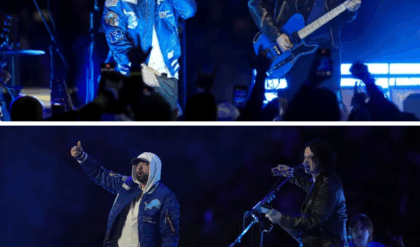In the dim-lit corridors of true crime obsession, where the line between fascination and revulsion blurs like blood on a bedsheet, Ryan Murphy’s Monster has carved out a notorious niche on Netflix—a true crime anthology that doesn’t just recount horrors but dissects the fractured psyches behind them. Launched in 2022 with Evan Peters’ chilling turn as Jeffrey Dahmer, the series has since ballooned into a cultural juggernaut, blending meticulous period detail with unflinching psychological probes that leave viewers equal parts enthralled and exhausted. Season 1’s Dahmer – Monster: The Jeffrey Dahmer Story racked up 856 million hours viewed in its first month, sparking debates on exploitation while earning 13 Emmy nods. Season 2’s Monster: The Lyle and Erik Menendez Story in 2024 peeled back the layers of fratricide and familial trauma, grossing critical acclaim for its nuanced take on abuse cycles. And Season 3’s Monster: The Ed Gein Story, dropping in September 2025, unearthed the leather-bound legacies of the Wisconsin ghoul who inspired Norman Bates and Buffalo Bill, clocking 12.2 million views in its debut weekend alone. Now, as production revs up in the sun-baked sprawl of Los Angeles, Monster: Season 4 promises to swing the blade toward uncharted territory: the enigmatic world of female serial killers, anchored by the infamous Lizzie Borden but branching into the tangled vines of Aileen Wuornos’ rage-fueled rampage. With Sarah Paulson in final talks to embody Wuornos—the drifter turned deadeye who gunned down seven men along Florida’s highways—this chapter isn’t just another entry in Murphy’s macabre ledger; it’s a haunting elegy to women weaponized by worlds that broke them first. Set for a mid-2026 Netflix premiere, the season arrives as the anthology’s boldest pivot yet, trading male monstrosity for maternal myths and misplaced mercy.
The blueprint for Season 4 emerged from Murphy’s restless mind during a 2024 Vulture interview, where the Emmy-winning provocateur—whose resume spans American Horror Story‘s spectral spookfests to American Crime Story‘s courtroom crucibles—teased a shift in focus. “We’ve done the men who terrified us; now it’s time for the women who were told they couldn’t,” he mused, name-dropping Lizzie Borden as the linchpin. The 1892 Fall River axe murders—Borden’s father and stepmother hacked to ribbons in their own home—stand as America’s original female fury tale, a scandal that birthed nursery rhymes (“Lizzie Borden took an axe…”) and acquittals that still sting with injustice. Borden, the prim spinster who walked free amid whispers of inheritance and illicit affairs, becomes the season’s spectral throughline, her shadow stretching across centuries to illuminate other “monstrous” women. Enter Aileen Wuornos, the chain-smoking sex worker whose seven confirmed kills between 1989 and 1990 transformed her from roadside hustler to death row icon. Convicted on six counts and executed by lethal injection in 2002, Wuornos claimed self-defense against abusive johns, her raw courtroom rants—”I’m a serial killer!”—cementing her as a symbol of survival gone savage. Co-creator Ian Brennan, Murphy’s longtime scribe partner, envisions the season as a “rhizomatic reckoning,” where Borden’s axe echoes in Wuornos’ .22 caliber fury, probing how society scripts women as victims or villains, rarely both.
Filming kicked off in October 2025 under the relentless California sun, transforming Echo Park’s Victorian facades into Fall River’s fog-choked gloom and Van Nuys warehouses into Florida’s seedy motels. Murphy, ever the maximalist, has assembled a dream team of artisans: Oscar-nominated cinematographer James Laxton (Moonlight) to bathe scenes in sepia-stained dread, and composer Mac Quayle (Mr. Robot) to score the silences with dissonant strings that mimic a heartbeat skipping toward snap. The budget, swelling to $25 million per episode across eight installments, affords lavish recreations: Borden’s blood-spattered parlor lit by gas lamps flickering like guilty consciences, Wuornos’ rain-lashed truck stops where desperation drips from every downpour. Production insiders whisper of innovative flourishes—split-screen timelines juxtaposing Borden’s trial sketches with Wuornos’ mugshots, voiceover monologues blending archival audio with actor improvisations—to capture the eerie continuity of female infamy. “These women didn’t wake up monsters; they were forged in forges we built,” Murphy told a closed-set visit, his eyes alight with the ethical tightrope he treads. Past seasons drew fire for glamorizing gore—Dahmer’s cannibal chic, the Menendezes’ designer despair—but Murphy insists Season 4 prioritizes “the poetry of pain,” consulting survivors’ advocates and forensic psychologists to humanize without excusing.
Anchoring the Borden saga is Ella Beatty, the 24-year-old ingenue daughter of Annette Bening and Warren Beatty, whose breakout in The Great Gatsby musical hinted at her steely poise. Beatty’s Lizzie emerges not as a hatchet-wielding harpy but a corseted cauldron of repressed revolt—her wide-set eyes (a genetic nod to the real Borden’s gaze) flickering between filial devotion and feral outburst. “Lizzie’s the original girlboss gone wrong,” Beatty quipped during a craft services chat, her prep involving axe-swinging lessons that left her palms blistered. Flanking her is Charlie Hunnam, the Sons of Anarchy alum trading biker leathers for Andrew Borden’s starched collars, his portrayal of the tyrannical patriarch laced with patriarchal poison. Hunnam, fresh off Rebel Moon‘s interstellar grit, brings a rumbling menace to the role, his scenes with Beatty crackling with the unspoken suffocation of Victorian domesticity. As stepmother Abby, expect a casting coup: rumors swirl of Jessica Chastain slipping into the role, her redheaded intensity perfect for the “gold-digging” interloper whose demise sparks the scandal.
But the season’s thunderclap is Sarah Paulson’s potential Wuornos, a reunion that feels predestined after two decades of Murphy-Paulson alchemy. The 50-year-old chameleon—five-time Emmy winner for American Horror Story and the gold-standard Marcia Clark in The People v. O.J. Simpson—has long been Murphy’s muse, her face a canvas for his fever dreams: the spectral Cordelia in Coven, the unhinged Lana Winters in Asylum. Paulson, in final negotiations as of November 6, 2025, would channel Wuornos with the same visceral verisimilitude that won Charlize Theron her 2004 Best Actress Oscar for the biopic Monster. Theron’s transformation—ditching her ethereal beauty for Wuornos’ gaunt, gap-toothed grimace, chain-smoking through 160 pounds of prosthetic pallor—set the bar stratospherically high, grossing $64 million and birthing a subgenre of “Oscar bait” makeovers. Paulson, no stranger to metamorphosis (her Ratched Nurse Mildred was a vision of venomous vanity), teases a “rawer” take: less glamour, more grit, drawing from Wuornos’ taped confessions where paranoia pitched into prophecy. “Aileen’s rage was a roar against a world that chewed her up,” Paulson hinted in a cryptic Variety profile, her prep including rides with Florida truckers and therapy sessions unpacking the killer’s childhood of abandonment and assault. If inked, her arc—flashing forward from Borden’s era to Wuornos’ ’90s executions—would interweave via thematic tendrils: both women, orphans of expectation, wielding weapons as warped extensions of self-defense.
The ensemble blooms with bold strokes. For Borden’s era, Naomie Harris eyes the role of housemaid Bridget Sullivan, the Irish immigrant whose testimony turned the trial into tabloid tinder; her quiet complicity a counterpoint to Lizzie’s bluster. In Wuornos’ timeline, Mickey Rourke rumors as a sleazy motel proprietor, his gravelly growl echoing the johns who met her barrel. Murphy’s penchant for cameos shines: expect a spectral Julianne Moore as Elizabeth Báthory, the “Blood Countess” whose 16th-century bloodbaths prefigure the season’s crimson chorus, linking Hungarian horrors to American axes. And in a meta flourish, Lily Rabe—Paulson’s AHS sister-in-arms who played Wuornos in Hotel‘s fifth season—pops up as a ’90s true crime podcaster dissecting Borden’s legacy, her voice a bridge between fact and fiction. Brennan’s scripts, laced with verbatim trial transcripts and Wuornos’ unfiltered jailhouse poetry (“I’ve earned my right to kill!”), promise the series’ signature blend: operatic dialogue that sings of societal sins, from Borden’s inheritance inequities to Wuornos’ sex work stigma.
What elevates Monster: Season 4 beyond binge fodder is its unflinching feminist forensics—a departure from the phallocentric focus of prior outings. Murphy, often pilloried for queerbaiting or shock value, here confronts his own blind spots: “Women killers are rare because the system’s rigged to make us martyrs first,” he reflected in a Netflix FYC panel. The season probes the “Madonna-whore” dichotomy—Borden the “fallen angel” of Fall River, Wuornos the “demon dyke” demonized by tabloids—while spotlighting ripple effects: how Borden’s acquittal emboldened vigilante visions in Wuornos’ mind, or Báthory’s baths inspired beauty myths masking brutality. Production’s authenticity push includes on-location shoots in Fall River’s Lizzie Borden Bed & Breakfast (yes, it’s a thing) and Florida’s backroads, consulting criminologists like Katherine Ramsland for Wuornos’ psyche. Quayle’s score, weaving hurdy-gurdies for Borden’s haunt with grungy guitars for Wuornos’ wanderings, underscores the temporal tango.
Fan frenzy has been a whirlwind since the October 9 Vulture drop, with #MonsterS4 spiking searches 300%. Season 3’s Gein glow-up—Hunnam’s hollow-eyed horror earning a Golden Globe buzz—primed the pump, but Wuornos whispers sent it stratospheric. Social scrolls overflow with Paulson-Paulson polls (“Marcia Clark vs. Aileen: Who wins?”), Theron throwbacks (“Charlize set the slay standard”), and Borden memes (“Give Lizzie an axe… and an Emmy”). Critics, wary of Murphy’s maximalism, early-buzz as “brilliant but bruising,” with Variety hailing the “female fatalism” as his sharpest satire yet. For Paulson, it’s a homecoming: post-All’s Fair on Hulu and AHS: Delicate‘s maternal madness, Wuornos lets her flex “the monster within the matron.” As Netflix’s true crime tide swells—Griselda with Sofia Vergara, Baby Reindeer‘s real-life ripples—Monster remains the alpha, its seasons a mirror to our morbid mirror-gazing.
Yet beneath the spectacle simmers scrutiny: Does glamorizing gore glorify it? Season 1’s Dahmer backlash—victim families decrying “trauma porn”—looms large, but Murphy vows “empathy engines,” ending episodes with resource reels for abuse survivors. As cameras roll toward wrap in February 2026, Monster: Season 4 beckons as the anthology’s apex: a blood-soaked ballad of broken blades, where axes and automatics alike carve truths from the carnage. Borden’s shadow, Wuornos’ snarl—they’re not just killers; they’re cautions, cries from the cracks of a cruel canon. Tune in mid-next year; Netflix’s menagerie of monsters grows wilder, and this time, the beasts have axes to grind.





